A 220 ohm resistor is a specific type of resistor with a resistance value of 220 ohms. Here are some key points about a 220 ohm resistor:
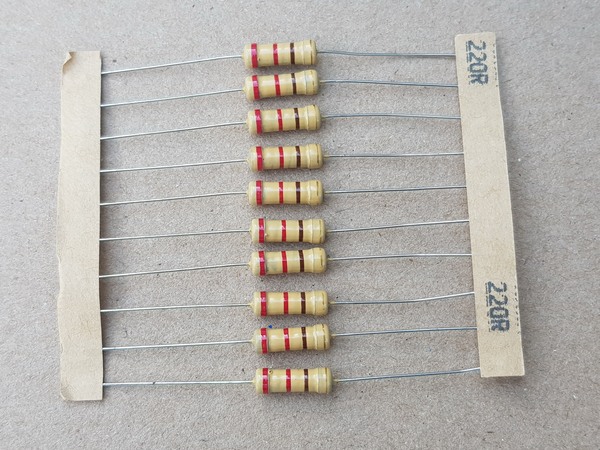
-
Resistance Value: A 220 ohm resistor restricts the flow of electric current in a circuit. It is designed to provide a specific amount of resistance, measured in ohms, to control the current flow according to Ohm's Law (V = I * R), where V is voltage, I is current, and R is resistance.
-
Tolerance: Like other resistors, a 220 ohm resistor may have a specified tolerance that indicates the maximum allowable deviation from the nominal resistance value. Common tolerance values for resistors include 5%, 1%, and others.
-
Power Rating: The power rating of the resistor specifies the maximum amount of power it can dissipate without getting damaged. The power rating is typically specified in watts and depends on the resistor's construction and material.
-
Color Coding: In through-hole resistors, the resistance value and tolerance are often indicated by colored bands. The color code for a 220 ohm resistor typically includes specific colors representing digits and a tolerance band.
-
Applications: A 220 ohm resistor can be used in various electrical and electronic circuits for purposes such as current limiting, voltage division, signal conditioning, biasing components in circuits, filtering, and other applications where precise resistance values are required.
-
LED Limiting Resistor: A 220 ohm resistor is commonly used in series with LEDs to limit the current flowing through them and prevent them from burning out due to excessive current.
-
Voltage Dropping: It can be used in voltage dropping applications where a specific voltage drop across the resistor is required.
Overall, a 220 ohm resistor is a standard electronic component that finds application in many types of circuits to control current flow, divide voltages, set biasing conditions, and perform other functions that involve the use of resistors with specific resistance values.
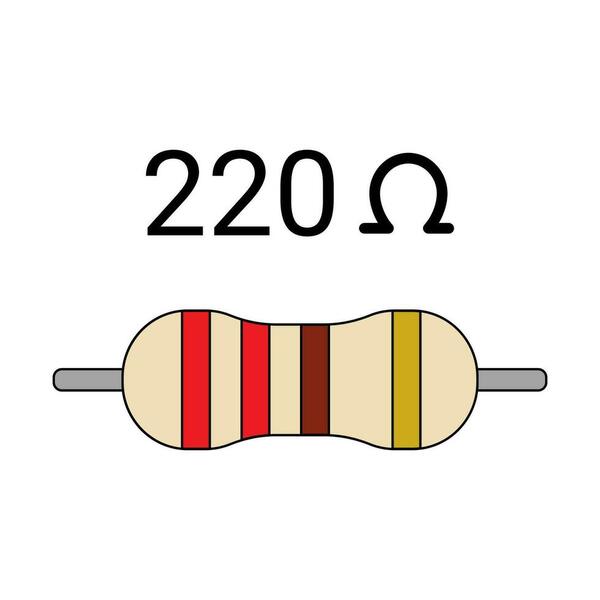
220 Ohm Resistor Feature
A 220-ohm resistor, like any other resistor, possesses specific features that make it suitable for various applications in electronics. Here are some common features and characteristics of a 220-ohm resistor:
-
Resistance Value: The primary feature of a 220-ohm resistor is its resistance value of 220 ohms, which determines the amount of opposition it provides to the flow of electric current passing through it.
-
Tolerance: Resistors have a tolerance rating that indicates the allowable deviation from the specified resistance value. Tolerance values for resistors such as 220-ohm resistors are typically 5%, 1%, or other values, representing how close the actual resistance can be to the specified value.
-
Power Rating: Another important feature is the power rating of the resistor, which signifies the maximum amount of power the resistor can dissipate without getting damaged. The power rating is specified in watts and depends on the physical size and material of the resistor.
-
Accuracy: Resistors, including 220-ohm resistors, have a level of accuracy that determines how closely the actual resistance aligns with the specified value. Higher accuracy resistors are often needed in precision applications.
-
Temperature Coefficient: The temperature coefficient of a resistor indicates how its resistance changes with temperature variations. It is specified in parts per million per degree Celsius (ppm/°C) and is crucial for stability in different environmental conditions.
-
Construction Type: 220-ohm resistors are available in various construction types, including through-hole resistors, surface-mount resistors, wirewound resistors, thick film resistors, and others, each with its own characteristics suited for different applications.
-
Physical Size: The physical size of the resistor can vary based on its power rating and construction. More power-dissipating resistors are typically larger to handle the heat generated.
-
Material: Resistors can be made from different materials, such as carbon film, metal film, wirewound, or thick film, each offering distinct characteristics in terms of accuracy, stability, and power handling capabilities.
-
Applications: 220-ohm resistors find applications in various circuits including LED current limiting, voltage dividers, biasing circuits, signal conditioning, filters, current limiting circuits, and measurement circuits where a 220-ohm resistance is required.
Understanding these features helps in selecting the right resistor for a specific application based on factors such as accuracy requirements, power handling capability, temperature stability, and other considerations to ensure optimal performance in the circuit.

220 Ohm Resistor Package
A 220-ohm resistor, like other resistors, comes in various package types depending on the intended application and manufacturing specifications. Here are some common package types for a 220-ohm resistor:
-
Through-Hole Resistor: Through-hole resistors have axial leads that are inserted into holes on a circuit board for soldering. These are often used in hand-soldered applications and are available in different sizes and power ratings.
-
Surface-Mount Resistor (SMD): Surface-mount resistors are designed for automated assembly and are soldered directly onto the surface of a circuit board. SMD resistors come in various package sizes such as 0402, 0603, 0805, etc., denoting their dimensions.
-
Axial Resistor: Axial resistors have leads attached to either end of a cylindrical resistor body. They are commonly used in through-hole applications and are suitable for through-hole soldering.
-
Chip Resistor: Chip resistors are surface-mount resistors that come in a rectangular package. They are smaller and lighter than through-hole resistors, making them ideal for high-density mounting on PCBs.
-
Network Resistor Package: In some cases, resistors are packaged together in resistor networks, which are multiple resistors housed in a single package. These are used when precision matching of resistors is required.
-
Variable Resistor (Potentiometer): Variable resistors, or potentiometers, are adjustable resistors that allow the resistance value to be varied manually. These are often used for control applications.
The choice of package type for a 220-ohm resistor will depend on factors such as the assembly method (hand-soldered vs. automated assembly), space constraints on the PCB, power dissipation requirements, and other design considerations specific to the circuit.
It's important to ensure that the chosen package type meets the requirements of the circuit design and provides the necessary functionality and performance for the intended application when selecting a 220-ohm resistor.
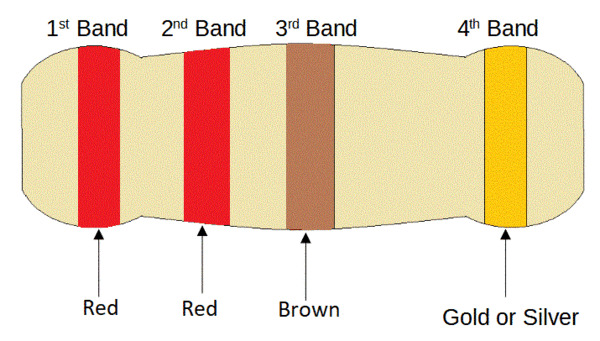
220 Ohm Resistor Color Code
For a 220-ohm resistor, the resistor color code can be represented as follows:
- Red: 2 (second digit)
- Red: 2 (first digit)
- Brown: 0 (multiplier)
- Gold: Tolerance of +/- 5%
Therefore, in a standard 4-band resistor color code scheme:
- First band (2): Red
- Second band (2): Red
- Third band (0): Brown
- Fourth band (Multiplier - Ohms): Gold
- Fifth band (Tolerance): Gold
This color code indicates that a resistor with red, red, brown color bands and a gold tolerance band would have a resistance value of 220 ohms with a tolerance of +/- 5%.

How to Read the 220 Ohm Resistor Color Code
To read the color code of a 220 ohm resistor, you should understand the standard color code system used for resistors. This system involves color bands that represent digits, multipliers, and tolerance values. Here is how you can read the color code for a 220 ohm resistor:
-
Determine the Color Bands: A 220 ohm resistor typically has four or five color bands. Each color band represents a specific value:
- First band: Represents the first digit of the resistance value.
- Second band: Represents the second digit of the resistance value.
- Third band: Represents the multiplier.
- Fourth band: Represents the tolerance (optional for four-band resistors).
-
Identify the Colors: Match the colors of the bands to their corresponding values using the standard color code chart. The color code for a 220 ohm resistor is as follows:
- Red: 2 (second digit)
- Red: 2 (first digit)
- Brown: 0 (multiplier)
- Gold: Tolerance of +/- 5%
-
Calculate the Resistance Value: Use the information from the colors to determine the resistance value of the resistor:
- The first digit (Red) is 2.
- The second digit (Red) is 2.
- The multiplier (Brown) is 10^1 (10).
Therefore, the resistance value is calculated as: Resistance = (Digit 1 * 10 + Digit 2) * 10^Multiplier = (2 * 10 + 2) * 10^1 = (20 + 2) * 10 = 220 ohms
-
Consider the Tolerance: The gold band on a resistor indicates a tolerance of +/- 5%. This means that the actual resistance of the resistor can vary by up to 5% from the stated value of 220 ohms.
By following these steps and using the color code chart as a reference, you can accurately read the color code of a 220 ohm resistor and determine its resistance value and tolerance.
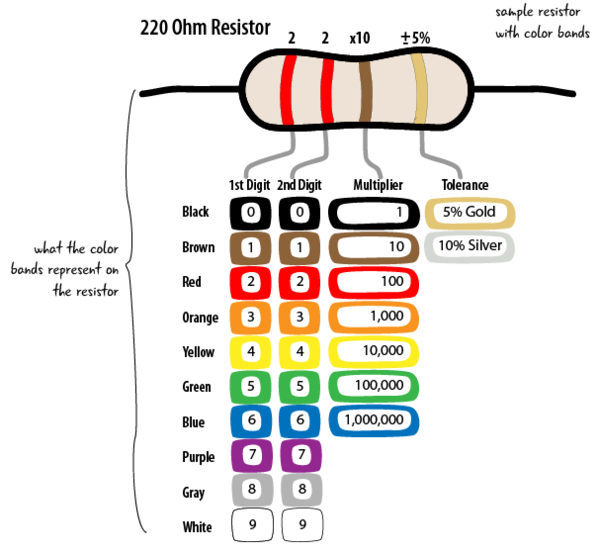
The 4 Band 220 Ohm Resistor
To read a four-band color code for a 220-ohm resistor, you need to interpret the colors on each band according to the standard resistor color code. Here's how you can read a four-band color code for a 220-ohm resistor:
-
Identify the Color Bands: In a four-band color code system, you will typically have the following color bands representing different values:
- Band 1 (First Digit): The first significant digit of the resistance value.
- Band 2 (Second Digit): The second significant digit of the resistance value.
- Band 3 (Multiplier): Multiplier that determines the number of zeros to follow the significant digits.
- Band 4 (Tolerance): Tolerance of the resistor.
-
Interpret the Colors: For a 220-ohm resistor, the colors of the bands correspond to specific values as follows:
- Red: 2 (Second digit)
- Red: 2 (First digit)
- Brown: 10 (Multiplier)
- Gold: 5% (Tolerance)
-
Calculate the Resistance Value:
- The first digit (Red) is 2.
- The second digit (Red) is 2.
- The multiplier (Brown) is 10^1 (10).
Using these values:
Resistance = (Digit 1 * 10 + Digit 2) * 10^Multiplier = (2 * 10 + 2) * 10^1 = (20 + 2) * 10 = 220 ohms
-
Consider the Tolerance: The gold band on a resistor generally indicates a tolerance of +/- 5%. This means that the actual resistance of the resistor can vary by up to 5% from the specified value of 220 ohms.
By interpreting the colors correctly and using the resistor color code chart, you can determine that a resistor with the color bands Red-Red-Brown-Gold represents a 220-ohm resistor with a tolerance of +/- 5%.
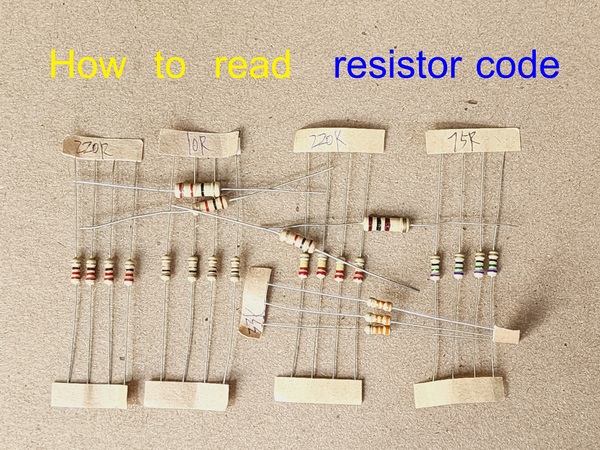
4-Band vs. 5-Band vs. 6-Band 220 Ohm Resistor Color Code
When looking at resistors with different numbers of bands in the color code system, there are differences in terms of precision and accuracy. Here is how the color codes would appear for a 220-ohm resistor in the 4-band, 5-band, and 6-band systems:
4-Band 220 Ohm Resistor Color Code:
- Red-Red-Brown-Gold:
- First digit: 2
- Second digit: 2
- Multiplier: 10^1 (10)
- Tolerance: +/- 5%
- This represents a standard 220-ohm resistor with a tolerance of +/- 5%.
5-Band 220 Ohm Resistor Color Code:
- Red-Red-Black-Brown-Gold:
- First digit: 2
- Second digit: 2
- Third digit: 0
- Multiplier: 10^1 (10)
- Tolerance: +/- 5%
- This provides an additional significant digit for increased precision compared to the 4-band code.
6-Band 220 Ohm Resistor Color Code:
- Red-Red-Black-Black-Brown-Gold:
- First digit: 2
- Second digit: 2
- Third digit: 0
- Multiplier: 10
- Tolerance: +/- 5%
- Sometimes a 6th band is added to provide a temperature coefficient.
Summary:
- 4-Band: Standard system, provides resistance value and tolerance.
- 5-Band: Adds an additional digit for increased precision.
- 6-Band: Adds another digit and can include a temperature coefficient.
The number of bands determines the level of precision and additional information conveyed by the resistor's color code. More bands generally indicate higher precision and more detailed specifications for the resistor.
220 Ohm Resistor Uses
A 220-ohm resistor can be used in various electronic circuits and applications due to its specific resistance value. Here are some common uses of a 220-ohm resistor:
-
LED Current Limiting: 220-ohm resistors are commonly used to limit the current flowing through light-emitting diodes (LEDs) in simple LED circuits. They help protect the LED from excessive current and prevent burnout.
-
Voltage Divider Circuits: In combination with other resistors, a 220-ohm resistor can be used in voltage divider circuits to obtain specific output voltages from a given input voltage.
-
Pull-Down or Pull-Up Resistors: In digital circuits, 220-ohm resistors can be used as pull-down or pull-up resistors to ensure that inputs to microcontrollers or logic gates are in a defined state when no active input signal is present.
-
Biasing Circuits: 220-ohm resistors are utilized in biasing circuits to set the operating point of transistors or other active components in amplifiers or signal processing circuits.
-
Current Limiting Applications: They can be used in various current limiting applications to control the amount of current flowing through a particular part of a circuit.
-
Signal Conditioning: In sensor circuits or analog signal processing, 220-ohm resistors can be used for conditioning signals and setting gain or impedance levels.
-
Voltage Level Shifting: They can be employed in level-shifting circuits to convert one voltage level to another, which is especially useful in interfacing between different components with varying voltage requirements.
-
Filter Circuits: 220-ohm resistors can be part of filter circuits along with capacitors and inductors to design low-pass, high-pass, band-pass, or band-stop filters for signal processing.
-
Waveform Generation: They can play a role in waveform generation circuits where specific resistance values are needed to shape waveforms according to the desired characteristics.
-
Amplifier Circuits: In combination with other resistors and components, 220-ohm resistors can be used in amplifier circuits for audio, RF, or other amplification purposes.
These are just a few examples of how a 220-ohm resistor can be utilized in electronic circuits for various functionalities and purposes. The versatility and ubiquity of resistors in electronics make them essential components in designing and building electronic systems.
Caution for 220 Ohm Resistor Code
When using a 220-ohm resistor in electronic circuits, there are a few precautions and considerations to keep in mind:
-
Power Rating: Ensure that the power rating of the resistor is sufficient for the application. Calculate the power dissipated in the resistor using P = I^2*R or P = V^2/R, where I is current, V is voltage, and R is resistance. Choose a resistor with a power rating higher than the calculated power dissipation to prevent overheating and potential damage.
-
Tolerance: Consider the tolerance of the resistor, which in the case of a 220-ohm resistor is typically +/- 5%. Understand the allowable deviation from the specified resistance value and how it may affect the performance of the circuit.
-
Temperature Coefficient: Be aware of the temperature coefficient of the resistor, which indicates how its resistance changes with temperature. For critical applications where temperature variations can affect performance, choose resistors with stable temperature coefficients.
-
Overcurrent Protection: Use a 220-ohm resistor within its current rating to prevent overheating and ensure the resistor operates within its safe limits. Exceeding the current rating can lead to failure and potentially damage other components in the circuit.
-
Mechanical Stress: Avoid bending or applying excessive mechanical stress to the resistor leads, as this can cause damage to the component or affect its electrical properties.
-
Soldering: When soldering the resistor onto a circuit board, ensure that the soldering iron temperature is appropriate and that the soldering process is done correctly to prevent damage to the resistor or the circuit board.
-
Storage and Handling: Store the resistors in a proper environment to avoid exposure to moisture, dust, or other contaminants that could degrade their performance. Handle the resistors with care to prevent damage to the components.
-
Testing and Verification: Test the resistance value of the resistor using a multimeter before installing it in a circuit to ensure that it matches the specified value of 220 ohms.
By being mindful of these precautions and handling the 220-ohm resistor carefully, you can ensure its proper functioning and longevity in electronic circuits.
Different Watt Types of 220 Ohm Resistor
When it comes to resistors, the wattage rating indicates the maximum power a resistor can safely dissipate without overheating. For a 220 ohm resistor, various wattage options are available depending on the application requirements. Here are some common wattage types for a 220 ohm resistor:
-
1/8 Watt Resistor: A 1/8 watt resistor is suitable for low-power applications where minimal power dissipation is needed. These resistors are commonly used in signal and control circuits where power requirements are low.
-
1/4 Watt Resistor: A 1/4 watt resistor is a versatile option suitable for a wide range of general-purpose applications. These resistors can handle slightly higher power dissipation compared to 1/8 watt resistors and are commonly used in various electronic circuits.
-
1/2 Watt Resistor: A 1/2 watt resistor can dissipate more power than 1/4 watt resistors. They are used in applications that require slightly higher power handling capabilities while still maintaining a relatively small size.
-
1 Watt Resistor: A 1 watt resistor is suitable for applications that involve moderate power dissipation. These resistors can handle more power compared to lower wattage options and are often used in power supplies, audio circuits, and other applications with moderate power requirements.
-
2 Watt Resistor: A 2 watt resistor is capable of dissipating even more power than 1 watt resistors. They are used in applications where higher power dissipation is necessary, such as in power amplifiers and some industrial equipment.
-
Higher Wattage Options: For applications that require even more power handling capabilities, higher wattage resistors, such as 3 watts, 5 watts, and even higher, are available. These resistors are used in power electronics, high-power amplifiers, and other applications with demanding power dissipation requirements.
When selecting a resistor for a specific application, it is essential to choose a resistor with the appropriate wattage rating to ensure it can handle the power dissipation requirements without overheating or being damaged.



